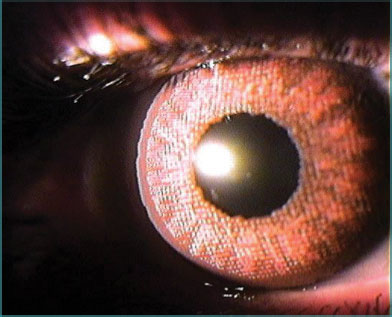In optometry school, we learn the basic fitting principles of both soft and gas permeable (GP) lenses. While the methods for fitting various types of contact lenses and evaluating the lens parameters may vary from school to school, the underlying basic tenets are the same: focus on the fit, vision and comfort of the lens. Only once we are satisfied with all three components and we know we are not doing any harm to the cornea should we finalize our contact lens prescription parameters.
In addition to the clinical wisdom shared during our schooling and in subsequent years of practice, manufacturers also provide guidelines on how we should begin the fitting process and evaluate and modify the fit of the specific lens. These fitting guides often provide unique insights into the products that contact lens fitters uncover during beta testing, which can save significant chair time during the fitting process.
With this information at our disposal, we must decide when to use these guides to help us with our fits and when to rely on the common practices learned in school and in the clinic. The answer, more often than not, depends on the lens design we choose for our patient and our knowledge base of that lens.
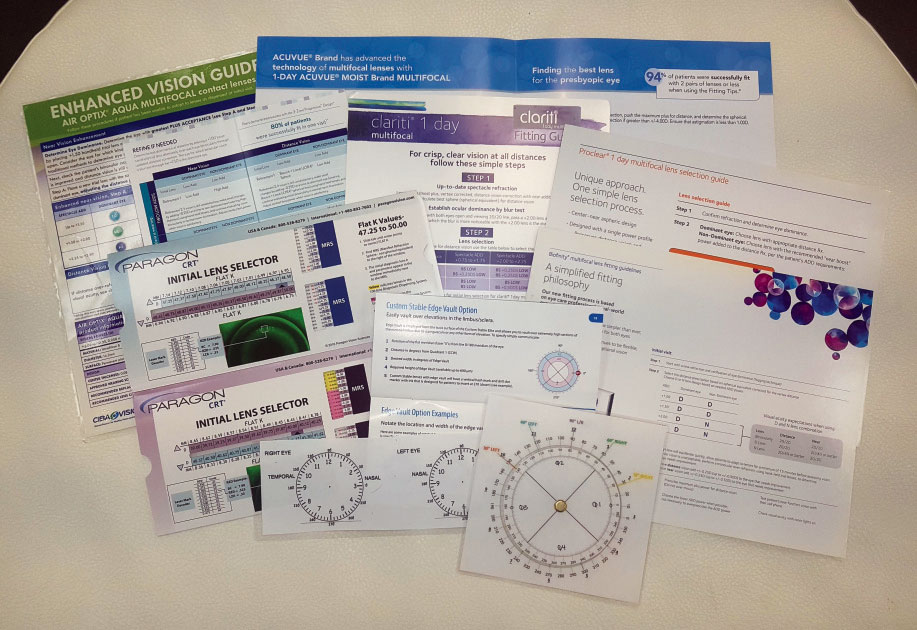 |
An assortment of fitting guides is available to help achieve the best possible comfort for your patient. |
Soft Contact Lenses
Several soft lens modalities exist, each with its own fitting principles:
Sphere and toric lenses. Most would agree that our schooling and clinical acumen allow us to fit all soft sphere and toric lenses on the market with relative ease, as the fitting process is quite simple and requires few follow ups. Manufacturers still provide fitting guides with all of their lenses explaining the basic principles of lens insertion, removal, assessment and prescription evaluation. When troubleshooting a patient complaint, we may turn to these resources to remind us of the type of prism design used in toric lenses or available base curve options.
• Clinical pearl: Contact lens fitters suggest, when fitting Dailies Total1 spherical lenses (Alcon), erring on the side of more plus and, when dealing with prescriptions higher than -3.00D, starting with a lens that is 0.25 less minus than what you would normally select.
Multifocal lenses. When multifocal contact lenses were first launched, optometrists fit them based on logical optical expectations. If a distance issue existed, clinicians simply added more minus. If a near issue was causing concern, a higher add power was needed. These simple principles, unfortunately, do not necessarily apply to the more complicated multifocal lenses of today.
Because each of today’s multifocal designs is a unique and complex pattern, it is important to use a fitting guide that provides a multitude of insights gained from fitters and lens designers on how to properly fit and troubleshoot each lens based on the specific design. These fitting guides can help you save a significant amount of time and frustration by simplifying the process. The biggest mistake we can make is not following the fitting guide.
The basic steps to fit multifocal contact lenses are:
- Perform a ‘least minus, least add’ refraction for your patient.
- Determine eye dominance.
- Choose your modality, lens brand and grab your fitting guide.
- Choose your initial lenses based on the fitting guide and your spherical equivalent vertex refraction and add power.
- Insert the lenses and let them settle for 20 to 30 minutes. (You can see another patient meanwhile.)
- Evaluate binocular vision with real-world tasks at both distance and near.
- Troubleshoot complaints with a binocular distance over-refraction to adjust the spherical component of the multifocal lens.
- Make one change and let the patient try the lenses for a week.
At the follow up, perform another binocular distance over-refraction if problems exist. Follow the fitting guide to make changes to the add power of the lenses, if your patient’s problem is not solved.
- Clinical pearl: When fitting Proclear toric multifocal lenses (CooperVision), choose the 8.4mm base curve initially for greater success. For Proclear 1 day multifocal lenses (also from Cooper), choose an initial lens that is +0.50 more plus than what the fitting guide suggests. Our over-refractions have consistently shown a need for more plus.
- Clinical pearl: Keep the lights on during a multifocal fit, use real-word tasks to evaluate vision, over-refract with trial lenses (not your phoropter) and make only one change at a time.
When stocking your office with the right fitting sets, most decide to stock only the lenses they use regularly. However, the reverse is also often true: if you have a fitting set for a new lens, you are more likely to use it. You can begin a fit right away and have lenses on hand to make changes.
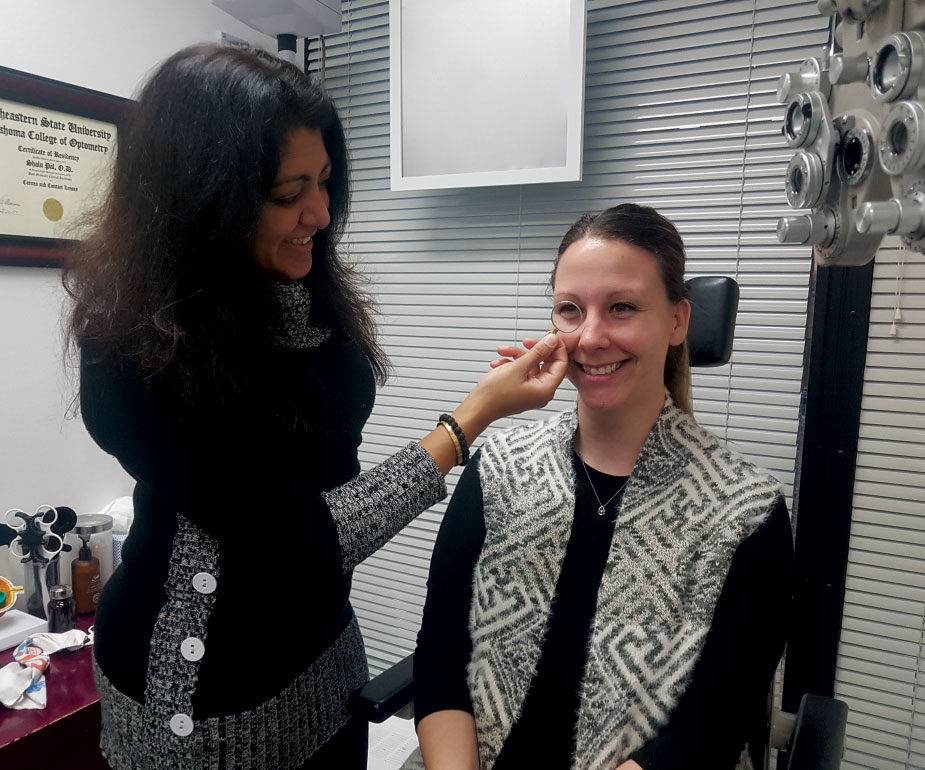 |
| Over-refracting the distance with both eyes open in bright illumination helps determine the most plus distance refractive correction. |
Custom soft lenses. The same fitting strategies for disposable soft contact lenses are used when fitting custom soft lenses. However, a few things differ with respect to the fitting sets and fitting guides. Fitting sets are not customarily provided for sphere and toric lenses due to the vast parameters available and low frequency of use relative to disposable lenses.
However, soft custom multifocal and multifocal toric lenses have fittings sets you can purchase if you find that you use these lenses often enough. Lenses are typically ordered empirically with the assistance of a lab consultant. An equivalent disposable lens can be helpful to test the fit of a lens prior to ordering the custom product.
Fitting guides for these lenses are most frequently used to remind us of the wide range of parameters available, as few practitioners have them memorized.
The data that you should provide your lab with to order these custom soft lenses include:
- Keratometry readings
- Prescription
- Horizontal visible iris diameter (HVID)
- Pupil size
- Fissure size
- Eye dominance
- Topographies
- Current contact lens brand, base curve and fit assessment if your patient is a current contact lens wearer.
Fitting guides provide strategies or tests to perform prior to contacting the lab for help if we run into a problem with a fit. An example is performing a keratometric reading over top of the lens or over-refracting a multifocal if vision is not acceptable to a patient.
Prosthetic LensesWhen fitting prosthetic colored contact lenses, fitting sets and fitting guides are particularly helpful. With them, you can demonstrate and perfect the color choice and meet the patient’s expectations. Matching the non-affected eye is most often the patient’s primary concern. Fitting guides allow you to understand the level of layering and complexity of coloring at your disposal to build the perfect prosthetic.
|
Hybrid Lenses
Hybrid lenses combine the comfort of soft lenses with the exceptional optics of GP lenses. Currently, SynergEyes is the sole hybrid lens manufacturer in the United States, and the company provides several lens designs based on the type of cornea you are fitting. You can order some of their lenses empirically with their online calculators, while other designs require a fitting set. The Duette and Duette Progressive hybrid lens can be ordered empirically. You will need keratometry readings, a manifest refraction and the HVID. The other lenses in the hybrid portfolio should be fit with a fitting set.
The fitting sets, along with the fitting guides and training videos, are a great resource to learn how to fit these lenses. It’s difficult to deviate from this learning structure in the beginning but, as you become more familiar with these lenses and how changing the base curve, sagittal height or skirt size impacts the overall fit, you will be able to choose a different starting point within the fitting set based on the topographies of your patient’s eye profile.
If changes need to be made to the diagnostic lens, a call to consultation can be very helpful until you become accustomed to the changes you can make to the available parameters.
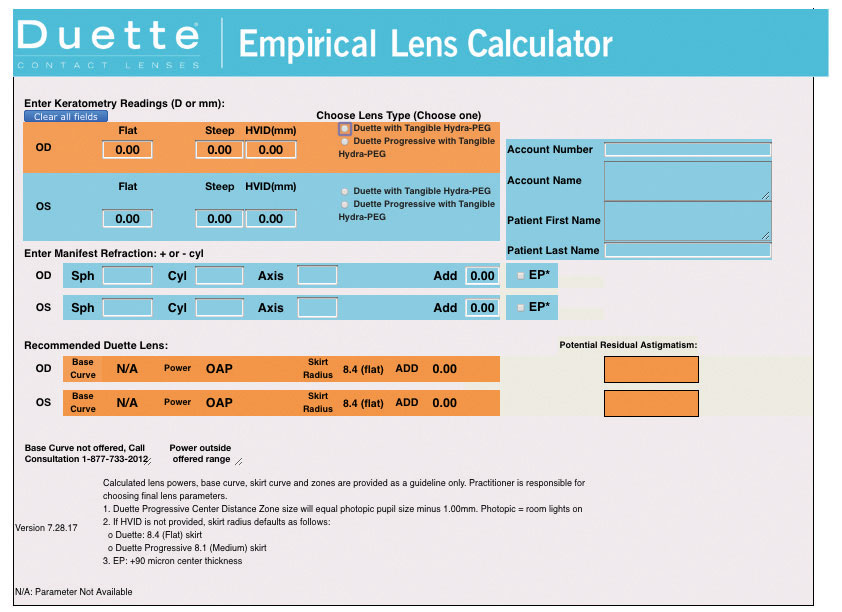 |
| To order Duette or Duette Progressive hybrid lenses empirically, you can use the Duette online calculator. |
Clinical pearls:
- When using the fitting set, start with the 250 medium skirt lens.
- The lens will settle and should be evaluated after three to four hours of wear in order to assess height.
- Medium skirts fit best with small corneas, and flat skirt fit best with large corneas.
- The multifocal lens design has both center near and center distance. The center distance design can be used for myopia control.
GP Lenses
These lenses are fully customizable, with specific curve, width, diameter and thickness. Many GP lens designs also come with pre-set parameters to aid in the fitting process. Clinicians have three different methods for properly designing a custom GP lens:
Formulas. We can design a bicurve, tricurve or tetracurve lenses, based on formulas and expected curves or we can use a fitting set. A fitting set chooses the parameters for you based on the labs design of choice. Your job is to find the best matching lens and make small modifications to it to match your patient’s needs.
When designing a lens from scratch based on lid anatomy, you need to decide if you are going to fit a lens that is lid-attached or fits interpalpebral. The method you choose will determine how to build your lens. Lid-attached lenses are fit larger and flatter, and interpalpebral lenses are fit smaller with a steeper base curve. Choose base curves and widths of the secondary, tertiary and quaternary curves yourself or you can use default standards that your lab provides. A great resource you can take advantage of to learn how to design GP lenses from scratch is The Manual of Gas Permeable Contact Lenses, 2nd Edition.
Empiric. You can also order GP lenses empirically, by giving the topographies, keratometric values, pupil sizes, iris diameters, lid positions, fissure heights and refractions to a lab consultant who then designs the lens for you.
Fitting sets. Many manufacturers provide a fitting set and corresponding fitting guide for their GP lenses. The fitting set will allow you to see the lens on the eye and determine any necessary lens adjustments. Because of the complexity and proprietary nature of lens designs, you may not know all of the specific parameters of a given lens, requiring you to rely on the fitting guide to help you understand the impact of the fitting process.
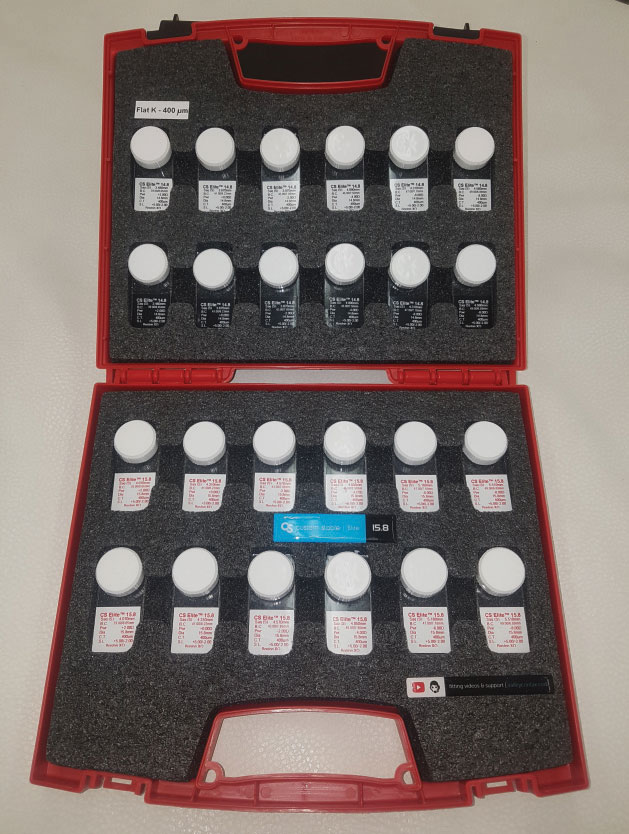 |
| A scleral lens diagnostic fitting set, such as this one for the Valley Contax Custom Stable Elite, can help any practitioner learn more about on-eye performance of the final lens ordered. |
Scleral Lenses
As interest in these lenses grows, so does our refinement of fitting techniques and processes. When sclerals first hit the market, little could be done to modify their fit. Optometrists who continue to fit scleral lenses as they advance have learned how to fit them with each new breakthrough. With the use of available fitting guides, the learning curve is much smaller than it once was.
Despite having significant experience with scleral lenses, fitting sets and fitting guides are a must when learning about new products. They provide step-by-step instructions on how to fit a lens, evaluate each fitting curve and make any possible changes to the curve, power and diameter.
When fitting scleral lenses communication to help ease fear is the first and most important step to success. Insertion and removal is often the reason why patients fail with scleral lenses. Make sure to master this so you are able to teach your patients. Fit the lens first (sagittal height, limbal clearance and edge design) before you worry about optics.
The lens will rotate, and optics will change as you change the lens. Work with the sphere power of the prescription only until the fit is complete, and then do a final sphero-cylinder over-refraction to finalize the prescription. Do not add cylinder to the scleral lens unless there is a significant change in vision.
With these lenses, a single change to one curve can have a huge impact on all of the lens curves. Thus, you need to know the fitting properties of the landing zone, limbal zone and base curve and how changes to each will impact the others. The increments of change that are possible for each zone are important to know. Your lab consultant or the fitting guide will provide you with these vital pieces of information that will help you understand the lens design and achieve success with these specialty lenses.
Unique scleral lens features include quadrant-specific designs, toric peripheral curves, front toric prescription options, multifocal front surface designs, notching and micro-vaulting capabilities. Each of these specific designs comes with their own fitting challenges, which can be alleviated by using the fitting guide or consulting with your lab. Understanding the modification options that your scleral lens brand has and the parameters for those modifications is the first step. If you have residual astigmatism in your refraction, you can add a front toric design to most scleral lenses on the market. We are using more toric peripheral curves these days because the sclera is more irregular the further you move away from the limbus. Toric peripheral curves help align the lens to the scleral.
Principles for multifocal lens designs apply to scleral lenses as well. Each company has their own method for choosing their starting design based on your refraction. Methods to adjust powers based on complaints can be found in their fitting guides. Notching and mirco-vaults are great options to avoid filtering blebs and pingueculas.
Clinicians who order scleral lenses empirically with the assistance of a corneo-scleral imaging topographer may not need a fitting set and fitting guide.
Your knowledge and fitting experience with a particular lens modality determines the extent to which you need to use a fitting guide, if at all. When working with a new product, the corresponding guide helps you achieve efficiency in the fitting process and learn how to maximize the benefits of the new lens. As your comfort level widens, you may find yourself deviating from the fitting guide to experiment and pushing boundaries to try to solve a patient’s complex issue.
Dr. Pal runs a specialty contact lens and dry eye practice in Toronto. She is chair of the AOA Contact Lens and Cornea Section Council, a member of the Women’s Advisory Board for Alcon and a speaker for Allergan’s dry eye faculty in Canada. She is a consultant for Alcon, Allergan, Bausch + Lomb, CooperVision, Johnson & Johnson Vision Care and Menicon, as well as a facilitator of the STAPLE lens fitting workshops.
